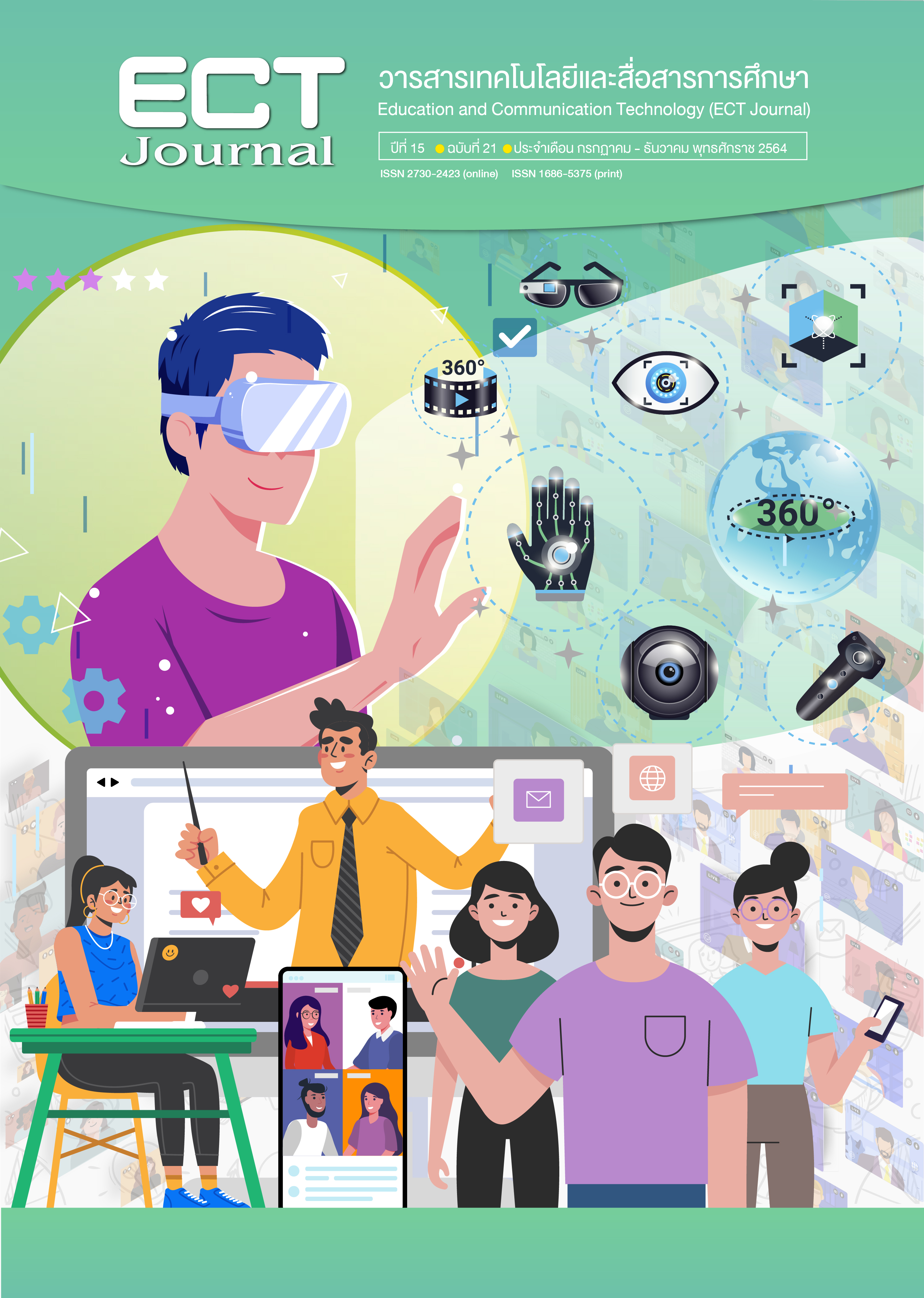องค์ประกอบและแนวคิดพื้นฐานการจัดการเรียนรู้แบบอิมเมอร์ซีฟ เพื่อส่งเสริมความฉลาดทางวัฒนธรรม
คำสำคัญ:
องค์ประกอบและแนวคิดพื้นฐาน, การจัดการเรียนรู้แบบอิมเมอร์ซีฟ, ความฉลาดทางวัฒนธรรมบทคัดย่อ
การจัดการเรียนรู้แบบอิมเมอร์ซีฟ เป็นการจำลองสภาพแวดล้อมโดยการใช้คุณลักษณะของเทคโนโลยีเสมือนจริงต่าง ๆเพื่อสร้างสภาพแวดล้อมสังคมเสมือนผสานศาสตร์การสอน (Sociotechnical-Pedagogical Usability) ตามหลักการปฏิสัมพันธ์ทางสังคมเกิดการเรียนรู้ไปพร้อมกับการพัฒนาความฉลาดทางวัฒนธรรม ผ่านการทำกิจกรรมร่วมกันอย่างไหลลื่นและเป็นธรรมชาติ โดยการจัดการเรียนรู้ดังกล่าวจะต้องคำนึงถึง3 มิติในการออกแบบได้แก่ (1) การใช้เทคโนโลยีที่ส่งเสริมการมีตัวตนในสังคม (Socio-Technical Usability) (2) การใช้ศาสตร์การสอนที่ส่งเสริมการมีปฏิสัมพันธ์ทางสังคม (Socio-Pedagogical Usability) และ (3) การใช้เทคโนโลยีที่ส่งเสริมศาสตร์การสอนอย่างเหมาะสม (Technical-Pedagogical Usability) ทั้งนี้การออกแบบเพื่อการผสานเทคโนโลยีในการสนับสนุนการเรียนรู้ทั้ง 3 มิติข้างต้น จะต้องตอบสนองการใช้งานที่มีประสิทธิภาพด้วยการใช้เทคโนโลยีที่สนับสนุนเนื้อหาและกระบวนการเรียนรู้ (Learning Subject) ที่หลากหลายให้ความเป็นอิสระแก่ผู้ใช้ (Autonomy) เพื่อการโต้ตอบและเชื่อมต่อระหว่างโลกจริงกับโลกเสมือนอย่างอย่างไม่สะดุด มีความสมจริง (Realism) เพื่อกระตุ้นและดึงดูดการเรียนรู้อย่างต่อเนื่องตลอดจนการใช้เทคโนโลยีที่สนับสนุนการแสดงตัวตน (Presence) โดยให้ผู้เรียนสามารถแสดงบุคลิก ทัศนคติ และพฤติกรรมบนโลกเสมือนให้ได้มากที่สุด อันเป็นปัจจัยสำคัญที่จะพัฒนาความฉลาดทางวัฒนธรรมได้อย่างมีประสิทธิภาพ
เอกสารอ้างอิง
กิดานันท์ มลิทอง. (2548). เทคโนโลยีและสื่อสารเพื่อการศึกษา. โรงพิมพ์อรุณการพิมพ์.
สำนักงานเลขาธิการสภาการศึกษา. (2562). รายงานการศึกษา เรื่อง แนวปฏิบัติของการสร้างและส่งเสริมการรู้ดิจิทัลสำหรับครู. บริษัท พริกหวานกราฟฟิค จำกัด.
สารวุฒิ ตรีศรี. (2561). การศึกษาความฉลาดทางวัฒนธรรมและปัจจัยที่มีอิทธิพลต่อความฉลาดทางวัฒนธรรมของนิสิตนักศึกษา: การวิจัยผสานวิธี [ปริญญานิพนธ์ปริญญาดุษฎีบัณฑิต, มหาวิทยาลัยศรีนครินทรวิโรฒ]. คลังข้อมูลดิจิทัล มหาวิทยาลัยศรีนครินทรวิโรฒ http://mscrollup.swu.ac.th/file/thesis_file_upload/Sarwud
Ang, S., & Van Dyne, L. (2008). Conceptualization of cultural intelligence: Definition, distinctiveness, and nomological network. In S. Ang & L. Van Dyne (Eds.), Handbook of cultural intelligence: Theory, measurement, and applications (pp. 3-15). M.E. Sharpe.
Badilla-Quintana, M. G., Sepulveda-Valenzuela, E., & Salazar Arias, M. (2020). Augmented reality as a sustainable technology to improve academic achievement in students with and without special educational needs. Sustainability, 12(19), https://www.mdpi.com/2071-1050/12/19/8116
Bandura, A. (1989). Social cognitive theory. In R. Vasta (Ed.), Annals of child development. Vol. 6. Six theories of child development. JAI Press.
Checa, D., & Bustillo, A. (2020). A review of immersive virtual reality serious games to enhance learning and training. Multimedia Tools and Applications, 79, 5501-5527. https://link.springer.com/article/10.1007/s11042-019-08348-9
De Back, T. T., Tinga, A. M., Nguyen, P., & Louwerse, M. M. (2020). Benefits of immersive collaborative learning in CAVE-based virtual reality. International Journal of Educational Technology in Higher Education, 17(51), 1-18. https://doi.org/10.1186/s41239-020-00228-9
Earley, P. C., & Ang, S. (2003). Cultural intelligence: Individual interactions across cultures. Stanford University Press.
Earley, P. C., & Mosakowski, E. (2004). Cultural intelligence. Harvard Business Review, 82(10), 139-146.
Jahnke, I., Schmidt, M., Pham, M., & Singh, K. (2020). Sociotechnical-pedagogical usability for designing and evaluating learner experience in technology-enhanced environments. In M. Schmidt, A. A. Tawfik, I. Jahnke, & Y. Earnshaw (Eds.), Learner and user experience research: An introduction for the field of learning design & technology. EdTech Books.
James, N., & Leese, B. (2020). Effective experiential learning. Practera.
Livermore, D. (2011). Leading with cultural intelligence: The new secret to success. AMACOM.
Marell-Olsson, E., & Jahnke, I. (2019). Wearable technology in a dentistry study program: Potential and challenges of smart glasses for learning at the workplace. In I. Buchem, R. Klamma, & F. Wild (Eds.), Perspectives on wearable enhanced learning (WELL) (pp. 433-451). Springer. https://doi.org/10.1007/978-3-319-64301-4_17
Oprean, D., & Balakrishnan, B. (2020). From engagement to user experience: A theoretical perspective towards immersive learning. In M. Schmidt, A. A. Tawfik, I. Jahnke, & Y. Earnshaw (Eds.), Learner and user experience research: An introduction for the field of learning design & technology. EdTech Books. https://edtechbooks.org/ux/10_from_engagement
Ramji, K., & Ivković, S. S. (2020). Developing cultural intelligence in WIL. World Association for Cooperative Education. https://waceinc.org/wace-global-conversation-4-developing-cultural-intelligence-in-wil
Thomas, D., & Inkson, K. (2003). Cultural intelligence: People skill for global business. Berrett-Koehler.
Van Dyne, L., Ang, S., & Livermore, D. (2010). Cultural intelligence: A pathway for leading in a rapidly globalizing world. In K. Hannum, B. B. McFeeters, & L. Booysen (Eds.), Leading across differences (pp. 131-138). Pfeiffer.
World Economic Forum. (2020). The future of jobs report 2020. https://www3.weforum.org/docs/WEF_Future_of_Jobs_2020.pdf
ดาวน์โหลด
เผยแพร่แล้ว
รูปแบบการอ้างอิง
ฉบับ
ประเภทบทความ
สัญญาอนุญาต
ลิขสิทธิ์ (c) 2021 มหาวิทยาลัยสุโขทัยธรรมาธิราช

อนุญาตภายใต้เงื่อนไข Creative Commons Attribution-NonCommercial-NoDerivatives 4.0 International License.
1. ทรรศนะและข้อคิดเห็นใด ๆ ที่ปรากฏอยู่ในวารสาร ECT Education and Communication Technology Journal เป็นของผู้เขียนโดยเฉพาะ สำนักเทคโนโลยีการศึกษา มหาวิทยาลัยสุโขทัยธรรมาธิราช และกองบรรณาธิการไม่จำเป็นต้องเห็นพ้องด้วย
2. กองบรรณาธิการของสงวนลิขสิทธิ์ในการบรรณาธิการข้อเขียนทุกชิ้น เพื่อความเหมาะสมในการจัดพิมพ์เผยแพร่






